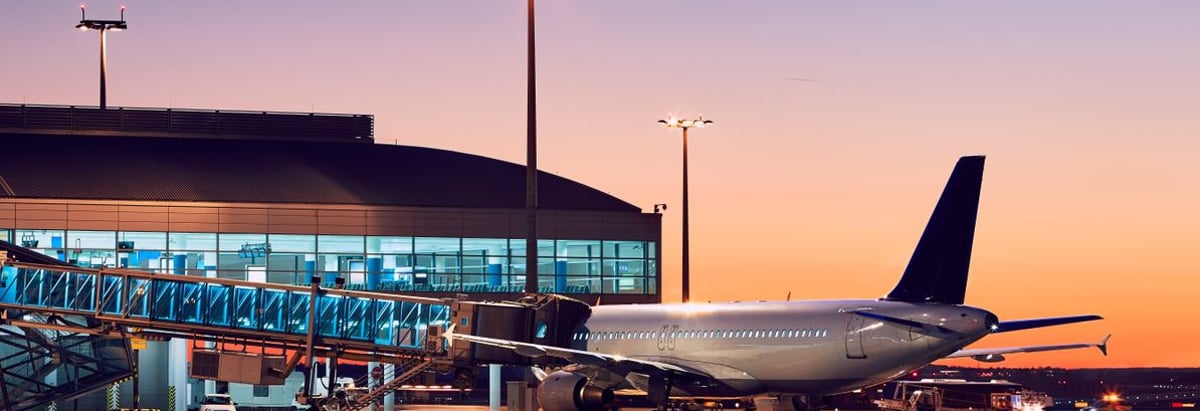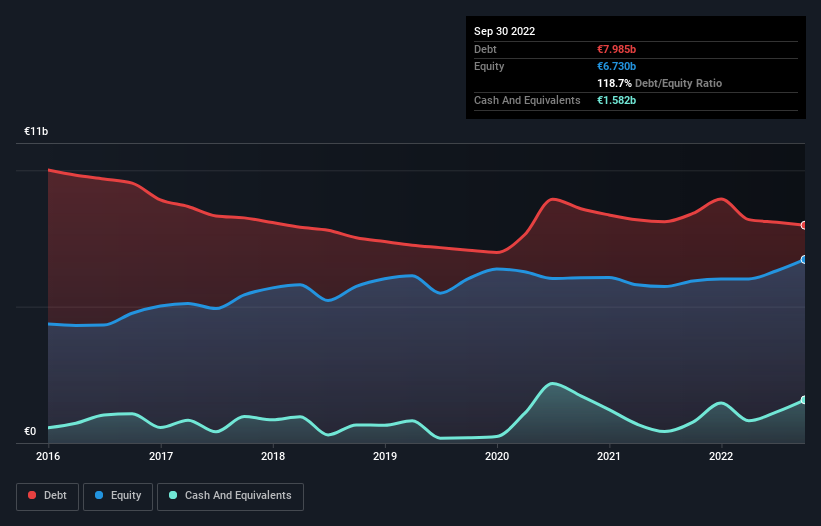
Howard Marks put it nicely when he said that, rather than worrying about share price volatility, 'The possibility of permanent loss is the risk I worry about... and every practical investor I know worries about.' So it seems the smart money knows that debt - which is usually involved in bankruptcies - is a very important factor, when you assess how risky a company is. We can see that Aena S.M.E., S.A. (BME:AENA) does use debt in its business. But the real question is whether this debt is making the company risky.
Why Does Debt Bring Risk?
Debt is a tool to help businesses grow, but if a business is incapable of paying off its lenders, then it exists at their mercy. Part and parcel of capitalism is the process of 'creative destruction' where failed businesses are mercilessly liquidated by their bankers. While that is not too common, we often do see indebted companies permanently diluting shareholders because lenders force them to raise capital at a distressed price. Having said that, the most common situation is where a company manages its debt reasonably well - and to its own advantage. The first step when considering a company's debt levels is to consider its cash and debt together.
Check out our latest analysis for Aena S.M.E
What Is Aena S.M.E's Net Debt?
You can click the graphic below for the historical numbers, but it shows that Aena S.M.E had €7.99b of debt in September 2022, down from €8.42b, one year before. However, because it has a cash reserve of €1.58b, its net debt is less, at about €6.40b.

How Strong Is Aena S.M.E's Balance Sheet?
Zooming in on the latest balance sheet data, we can see that Aena S.M.E had liabilities of €1.89b due within 12 months and liabilities of €7.47b due beyond that. Offsetting this, it had €1.58b in cash and €1.01b in receivables that were due within 12 months. So it has liabilities totalling €6.76b more than its cash and near-term receivables, combined.
While this might seem like a lot, it is not so bad since Aena S.M.E has a huge market capitalization of €18.0b, and so it could probably strengthen its balance sheet by raising capital if it needed to. But we definitely want to keep our eyes open to indications that its debt is bringing too much risk.
In order to size up a company's debt relative to its earnings, we calculate its net debt divided by its earnings before interest, tax, depreciation, and amortization (EBITDA) and its earnings before interest and tax (EBIT) divided by its interest expense (its interest cover). This way, we consider both the absolute quantum of the debt, as well as the interest rates paid on it.
Aena S.M.E has net debt to EBITDA of 4.2 suggesting it uses a fair bit of leverage to boost returns. But the high interest coverage of 7.6 suggests it can easily service that debt. Notably, Aena S.M.E made a loss at the EBIT level, last year, but improved that to positive EBIT of €775m in the last twelve months. When analysing debt levels, the balance sheet is the obvious place to start. But it is future earnings, more than anything, that will determine Aena S.M.E's ability to maintain a healthy balance sheet going forward. So if you want to see what the professionals think, you might find this free report on analyst profit forecasts to be interesting.
But our final consideration is also important, because a company cannot pay debt with paper profits; it needs cold hard cash. So it's worth checking how much of the earnings before interest and tax (EBIT) is backed by free cash flow. Happily for any shareholders, Aena S.M.E actually produced more free cash flow than EBIT over the last year. There's nothing better than incoming cash when it comes to staying in your lenders' good graces.
Our View
The good news is that Aena S.M.E's demonstrated ability to convert EBIT to free cash flow delights us like a fluffy puppy does a toddler. But we must concede we find its net debt to EBITDA has the opposite effect. We would also note that Infrastructure industry companies like Aena S.M.E commonly do use debt without problems. Looking at all the aforementioned factors together, it strikes us that Aena S.M.E can handle its debt fairly comfortably. On the plus side, this leverage can boost shareholder returns, but the potential downside is more risk of loss, so it's worth monitoring the balance sheet. The balance sheet is clearly the area to focus on when you are analysing debt. However, not all investment risk resides within the balance sheet - far from it. To that end, you should be aware of the 1 warning sign we've spotted with Aena S.M.E .
If, after all that, you're more interested in a fast growing company with a rock-solid balance sheet, then check out our list of net cash growth stocks without delay.
New: Manage All Your Stock Portfolios in One Place
We've created the ultimate portfolio companion for stock investors, and it's free.
• Connect an unlimited number of Portfolios and see your total in one currency
• Be alerted to new Warning Signs or Risks via email or mobile
• Track the Fair Value of your stocks
Have feedback on this article? Concerned about the content? Get in touch with us directly. Alternatively, email editorial-team (at) simplywallst.com.
This article by Simply Wall St is general in nature. We provide commentary based on historical data and analyst forecasts only using an unbiased methodology and our articles are not intended to be financial advice. It does not constitute a recommendation to buy or sell any stock, and does not take account of your objectives, or your financial situation. We aim to bring you long-term focused analysis driven by fundamental data. Note that our analysis may not factor in the latest price-sensitive company announcements or qualitative material. Simply Wall St has no position in any stocks mentioned.
About BME:AENA
Aena S.M.E
Engages in the management of airports in Spain, Brazil, the United Kingdom, Mexico, and Colombia.
Solid track record with adequate balance sheet.
Similar Companies
Market Insights
Community Narratives



